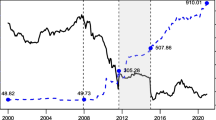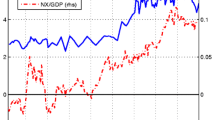Abstract
With the transition to the euro, exchange rate volatility between the countries participating in European Monetary Union has been eliminated, reducing uncertainty and transaction costs. The other side of the coin is the loss of the exchange rate as a potential mechanism of adjustment to external shocks. The present article uses the case of Germany to study the implications of EMU for labour markets.
Similar content being viewed by others
References
For a discussion and an analysis of the adjustment effects of monetary instruments before EMU see Claudia Müller, Herbert S. Buscher: The Impact of Monetary Instruments on Shock Absorption in EU-Countries, Discussion Paper No. 99-15, NEW Mannheim 1999.
Daniel Gros: Germany's Stake in Exchange Rate Stability, in: INTERECONOMICS, No. 5, 1996, pp. 236–240.
Ansgar Belke, Daniel Gros: Evidence on the Costs of Intra-European Exchange Rate Variability, Diskussionsbeiträge No. 13, Institut für Europäische Wirtschaft, Bochum 1997.
Alexander Jung: Is There a Causal Relationship between Exchange Rate Volatility and Unemployment?, in: INTERECONOMICS, No. 6, 1996, pp. 281–282.
Michael G. Duerr: Protecting Corporate Assets under Floating Currencies, New York, Conference Board, 1997.
Paul De Grauwe: International Trade and Economic Growth in the European Monetary System, in: European Economic Review 31, 1987, pp. 389–398.
Eric Perée, Alfred Steinherr: Exchange Rate Uncertainty and Foreign Trade, in: European Economic Review 33, 1989, pp. 1241–1264.
Joshua Aizenman, Nancy P. Marion: Volatility and the Investment Response, NBER, Working Paper 5841, 1996.
André Sapir, Khalid Sekkat: Exchange rate volatility and international trade: the effect of the European Monetary System, in: Paul De Grauwe, Lucas Papademos: The European Monetary System in the 1990's, pp. 182–198.
Roland Döhrn: Zur Wechselkursempfindlichkeit bedeutender Exportsektoren der deutschen Wirtschaft, in: RWI-Mitteilungen 44, 1993, pp. 103–116.
Peter B. Clark, Hamid Faruqee: Exchange Rate Volatility, Pricing-to-Market and Trade Smoothing, IMF Working Paper 126, Washington 1997.
Guiseppe De Arcangelis, Cristina Pensa: Exchange Rate Volatility, Exchange-Rate Pass-Through and International Trade: Some New Evidence from Italian Export Data, CIDEI Working Paper 43, Rome 1997.
The IMF (Exchange Rate Volatility and World Trade, Occasional Paper 28, Washington 1984)
In this context, Gros uses the value of the option of waiting as modelled by Avinash Dixit: Entry and Exit Decisions under Uncertainty, in: Journal of Political Economy, Vol. 97, 1989, No. 3, pp. 620–638.
See Deutsche Bundesbank: Aktualisierung der Außenwertberechnungen für die D-Mark und fremde Währungen, in: Monatsberichte der Deutschen Bundesbank 1989 (4), pp. 44–49, here p. 46.
See Rudiger Dornbusch, Stanley Fischer: Makroökonomik, Munich 1992, p. 18.
Author information
Authors and Affiliations
Additional information
This research was undertaken with support from the Deutsche Post-Stiftung (German Mail Foundation) in the project ‘Arbeitsmarkt-effekte der Europäischen Währungsunion’ (Labour Market Effects of European Monetary Union). Helpful comments from our colleagues Thiess Büttner and Friedrich Heinemann are gratefully acknowledged. We are also indebted to Ingo Sänger for excellent research assistance. All remaining errors are our own.
Rights and permissions
About this article
Cite this article
Stirböck, C., Buscher, H.S. Exchange rate volatility effects on labour markets. Intereconomics 35, 9–22 (2000). https://doi.org/10.1007/BF02927896
Issue Date:
DOI: https://doi.org/10.1007/BF02927896




